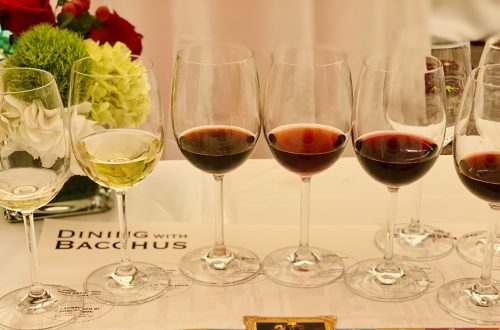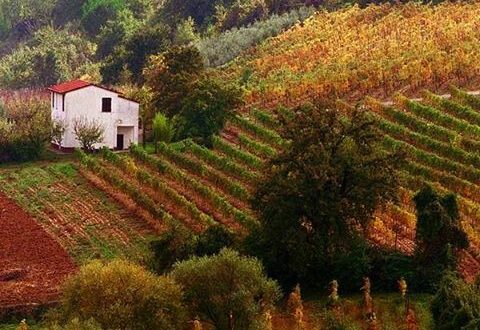Red, White, Rosé and…Orange Wine

Knock knock. It’s orange. Orange who? Orange you surprised? Yes. Many have been surprised, not only by my bad joke…but by the fact that Orange Wine is a thing. However, Orange Wines are not a new thing. They have been around for centuries, as in 5000 years or so and originated in Georgia (Eurasia). Orange wines have only recently garnered more attention and circulation in North America. Contrary to what the name may imply, orange wine is not produced by using oranges. Instead, the orange hue results when grapes have remained in contact with skin for a longer period of time–longer than the time required to make a rosé. If the grapes are left with the skin and seeds to macerate for an even long period, a red wine is made. Therefore, time is a key factor in making different shades of wine. Orange Wines, also known as “skin-fermented wines,” are found in many different parts of the world. They can be found the U.S., Italy, France, Greece, Slovania, Austria, Australia, South Africa and other regions. Let’s talk more on Orange Wine made in Italy.
 |
Radikon Ribolla Gialla
Friuli-Venezia Giulia
Italy |
 |
COS Pithos Bianco
Sicily, Italy |
These copper-colored wines were common in Italy in the 1950’s and 60’s. Today, they are produced in several regions in Italy. We will only highlight a few. In the North, Friuli-Venezia Giulia, Veneto, Lombardy and Emilia-Romagna produce orange wine. There’s Radikon Ribolla Gialla from Friuli-Venezia Giulia, which uses ribolla gialla grapes, Ageno La Stoppa in Lombardy, made from Malvasia and Ortrugo grapes, and then Dinavolino Bianco in Emilia-Romagna, made from Malvasia, Marsanne, Ortrugo grapes. In central Italy, Umbria makes a Terra dei Preti di Collecapretta using only Trebbiano grapes and a convent or monastery in Lazio produces Coenobium Ruscum Bianco with Trebbian, Grechetto and Malvasio grapes. Finally, in the south, there’s Bechar Fiano di Avellino, made with Fiano, which happens to be a DOCG wine. Sicily uses the Grecanico grapes to make COS Pithos Bianco in Sicily. Again, this is certainly not an exhaustive list, but just a few of the Orange wines produced in different Italian regions.
In terms of taste, orange wines are are known to have more texture and body than most white wines. Moreover, they are typically more bold, dry and tannic due to the longer maceration. We tasted COS Pithos Bianco (Sicily) Orange wine in Italy and can attest to its full-bodied characteristics. Meanwhile, Orange wines are not cheap and not that easy to find in the Northeast. Nevertheless, we were able to get our hands on a good one. Sorry folks-it’s not from Friuli or Sicily.
The Wining Hour’s Orange Wine Selection:
Our search for Orange Wine brought us to Umbria..and our friends at The Village Wine Merchants. We tasted a 2011 Paolo Bea Santa Chiara Bianco from Montefalco, Umbria. This wine comes from his Antica Anzienda Agricola Farm and Winery, which is completely organic. The grapes are organic and the wine is made without additives or intervention. The labels for the wine are even hand-written with a description of ingredients. To attain its beautiful orange color, this wine went through maceration with its skin for almost a month. Then it was aged for an even longer period of time on its lees in stainless steel, without any filtering along the way.
Paolo Bea’s Santa Chiara Bianco (Orange) Wine is a blend of Grechetto, Malvasia, Garganega, Sauvignon Blanc and Chardonnay grapes. Definately dark gold and orange in appearance, this wine is fascinating. We couldn’t help but marvel and the copper-tone rims as they swirled and then slid down the glass. The bouquet emitted quickly and powerfully. On the nose, we immediately detected the sweet smell of honey and bourbon, with a hint of summer fruits. I must say, the appearance and nose on this wine were deceiving. We were expecting a much sweeter wine.
Instead, it had mild tropical fruits like apricot and melon on the palate and was rather dry. Paolo Bea’s Orange wine had ripe tannins, and if tasted blind, it could have been mistaken for a red wine. Although the notes of flint and other minerals might have given it away. This 13% ABV Orange wine had a lingering finish.
 We paired this wine with *baked clams (recipe follows), but it could have handled much more. As this wine was hearty enough to pair with something meats and richer dishes, it showed some versatility. Paolo Bea Santa Chiara Bianco would be a great choice to accompany pasta, roasted fish, white meats, vegetables and even fresh fruit. So, after careful deliberation, we would have to say that Orange wine is not just a hipster wine, but instead, it’s a traditional wine here to stay.
We paired this wine with *baked clams (recipe follows), but it could have handled much more. As this wine was hearty enough to pair with something meats and richer dishes, it showed some versatility. Paolo Bea Santa Chiara Bianco would be a great choice to accompany pasta, roasted fish, white meats, vegetables and even fresh fruit. So, after careful deliberation, we would have to say that Orange wine is not just a hipster wine, but instead, it’s a traditional wine here to stay.
Orange you curious to read more about Orange Wine? Read on…
More on Orange Wine…Join us this Saturday, July 2 at 10am CDT on Twitter at #ItalianFWT to chat about skin-fermented white wines from Italy. Here’s what’s in store from our Italian blogging group:
David at Cooking Chat shares “Bressan Pinot Grigio: Tasting an Orange Wine”
Martin at ENOFYLZ Wine Blog shares “Caspri Luna Blu and Grilled Moroccan Chicken”
Camilla at Culinary Adventures with Camilla shares “Piattino di Polpo e Patate with Skerk’s Malvasia”
Jennifer at Vino Travels shares “There is Red and White, but Orange Wines too?”
Mike at Undiscovered Italy shares “Gray Matters”
Jill at L’Occasion shares “What Your Madre Never Told You About Orange Wine“
Christy at Confessions of a Culinary Diva shares “The Aperitivo Hour with Orange Wine & Walnut Pesto”
Michelle at Rockin Red Blog shares “What Color is Your Wine? Mine May Be Orange“
Li at The Wining Hour shares “The Road to Orange Wine in Umbria”
Jeff at FoodWineClick shares “Orange Duck, Orange Wine”
Baked Clams
1 dozen fresh clams, scrubbed
1/2 cup of chopped clams
1/2 cup of chopped shrimp
4 garlic cloves (diced)
3 tbsp oregano
3 tbsp parsley
1/4 cup of butter
1/2 cup of breadcrumbs
Combine all the ingredients in a bowl, except for the butter, 2 cloves of garlic and paprika. The clams can be made on the grill or sauteed in a pan. Cook them until them open. Remove from the pan. Separate each clam into two open shells. Then use a spoon to scoop out the batter and put it into the open clam shells. Sprinkle with paprika. Bake on 350 degrees for 20 minutes. Drizzle with butter and garlic. Bake for another 5-8 minutes.
About The Wining Hour
The Wining Hour writes about wine, Italy and global travel. The Wining Hour boutique caters to wine-lovers across the globe by offering all wine-related items. The Wining Hour markets unique wine décor and furnishings, accessories, glassware, barware, wine racks, storage and cooling options, games, gifts and more. The Wining Hour also hosts #wininghourchat on Twitter (@wininghourchat) on Tuesday’s at 9 p.m. EST.(For more, see links at the top of this page)
Follow The Wining Hour:



 We paired this wine with *baked clams (recipe follows), but it could have handled much more. As this wine was hearty enough to pair with something meats and richer dishes, it showed some versatility. Paolo Bea Santa Chiara Bianco would be a great choice to accompany pasta, roasted fish, white meats, vegetables and even fresh fruit. So, after careful deliberation, we would have to say that Orange wine is not just a hipster wine, but instead, it’s a traditional wine here to stay.
We paired this wine with *baked clams (recipe follows), but it could have handled much more. As this wine was hearty enough to pair with something meats and richer dishes, it showed some versatility. Paolo Bea Santa Chiara Bianco would be a great choice to accompany pasta, roasted fish, white meats, vegetables and even fresh fruit. So, after careful deliberation, we would have to say that Orange wine is not just a hipster wine, but instead, it’s a traditional wine here to stay.





